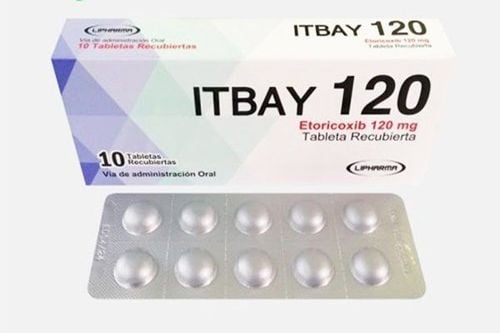This is an automatically translated article.
Ramitrez medicine has the main ingredient Etoricoxib 90 mg. This is an anti-inflammatory pain reliever, antipyretic, so it is only used in some medical cases. Patients need to strictly follow the doctor's instructions or carefully read the information contained in each leaflet.
1. What is Ramitrez?
Ramitrez medicine has the main ingredient Etoricoxib 90 mg and excipients such as: microcrystalline cellulose, lactose monohydrate, povidone, sodium lauryl sulfate, sodium starch glycolate, magnesium stearate, talc, hydroxypropylmethylcellulose, titanium dioxide, polyethylene glycol 6000, mint green, sunset yellow, brilliant blue.
Ramitrez is made in the form of film-coated tablets that should be taken orally.
2. Indications and contraindications to the drug Ramitrez
2.1. Indications How does the drug Ramitrez work? Ramitrez is indicated in the following cases:
Osteoarthritis. Acute gout attack. Rheumatoid arthritis Acute pain due to dental surgery. Primary dysmenorrhea. Chronic musculoskeletal pain. 2.2. Contraindications Contraindicated to use Ramitrez in the following cases:
Patients with hypersensitivity to any component of the drug. People with stomach ulcers or gastrointestinal bleeding. Severe liver failure. Severe renal impairment (ClCr < 30 mL/min). People with a history of asthma, acute rhinitis, nasal polyps, angioedema, urticaria when using aspirin or NSAIDs. Pregnant women or women who are breastfeeding. Children under 16 years old. Cystitis. Severe congestive heart failure.
3. Dosage and how to use Ramitrez
3.1. How to take Ramitrez is a film-coated tablet that should be taken orally. Patients need to strictly follow the instructions and instructions of the doctor on how to use, dose and time to use the active ingredients in the drug to be absorbed and eliminated effectively.
3.2. Dosage Dosage of Ramitrez can be referred to as follows:
Osteoarthritis, chronic musculoskeletal pain, primary dysmenorrhea: The dosage is 60 mg/day. Rheumatoid arthritis: Dosage 90 mg/day. Acute gout attack, patients with acute pain due to dental surgery: Dosage 120 mg/day. The dose of 120 mg is only used in the acute phase. It should be noted: The above drug dosage is for reference only, patients need to take the drug exactly as directed and prescribed by the doctor to achieve the best effect.
Overdose: If the patient overdoses on the drug and appears dangerous complications, the adverse reaction should stop using and notify the doctor immediately.
4. Notes when using the drug Ramitrez
During the use of Ramitrez, the patient should pay attention to the following:
Use caution when using Ramitrez in patients with ischemic heart disease, kidney disease, liver disease, heart disease, dysfunction left ventricular function, hypertension, the elderly, dehydration, people at risk of edema. Cardiovascular thromboembolism risk: Non-steroidal anti-inflammatory drugs (NSAIDs), not aspirin, when administered systemically can cause patients to develop cardiovascular thrombosis, even myocardial infarction, stroke. stroke, more dangerous can lead to death. Accordingly, these risks may appear as early as in the first few weeks of taking Ramitrez, and these risks may also increase with duration of use. However, the risk of cardiovascular thrombosis is often observed when patients use high doses. During treatment with Ramitrez, the physician should perform periodic evaluation for the occurrence of cardiovascular events, even if the patient did not have prior cardiovascular symptoms. Patients should be alerted by their physician to signs of a serious cardiovascular event. Accordingly, the doctor should perform an examination for the patient as soon as these symptoms appear. To minimize the risk of adverse events, patients should use the lowest effective daily dose of etoricoxib for the shortest time. Pregnancy: The use of Ramitrez should be avoided during pregnancy, especially the 3rd trimester, because it can cause premature closure of the arteries. Pregnant women should only use etoricoxib-containing medicines during the first trimester of pregnancy if the potential benefit outweighs the risk to the fetus. Lactation: Currently, it is not known whether Ramitrez is excreted in breast milk. Therefore, the use of Ramitrez should be considered. A decision may be made whether to discontinue the drug or to discontinue nursing, depending on the importance of Ramitrez to the mother's health. Driving and using machines: There are currently no reports of the effects of Ramitrez on the ability to drive or use machines. However, if during the use of Ramitrez, the patient has symptoms of dizziness, it is necessary to limit driving and operating machinery.
5. Unwanted effects when using the drug Ramitrez
During the use of Ramitrez, patients may experience some of the following side effects:
Digestive disorders, diarrhea, abdominal bloating, indigestion, epigastric pain, body weakness, flu, dizziness , headache, increased liver enzymes. Uncommon side effects: Edema, anxiety, negative thinking, depression, insomnia, somnolence, blurred vision, tinnitus, heart failure, increased blood pressure. Risk of cardiovascular thrombosis In addition to the above side effects, if the patient experiences any other side effects, it is necessary to inform the doctor for timely examination and treatment.
6. Drug interactions
Ramitrez drug interactions that may occur during use are as follows:
Anticoagulants Warfarin: In patients who have been maintained on stable treatment with the anticoagulant warfarin when using a dose of etoricoxib 120 mg daily can increase prothrombin by about 13% compared with the standard rate. Therefore, INR values should be closely monitored when starting treatment with etoricoxib or when switching to etoricoxib, especially during the first days, while the patient is on anticoagulants. warfarin. Rifampin: Co-administration of the active ingredient etoricoxib with rifampin, a potent inducer of hepatic metabolisers, may reduce the AUC of etoricoxib by approximately 65%. Accordingly, this interaction should be taken into account when the active ingredient etoricoxib is co-administered with rifampin. Methotrexate: Close monitoring is required for methotrexate toxicity when co-administered with the active ingredient etoricoxib in doses greater than 90 mg daily and methotrexate. Angiotensin-converting enzyme (ACE) Inhibitors: Currently, there have been reports of non-selective NSAIDs, selective COX-2 inhibitors reducing the antihypertensive effect of enzyme inhibitors. converting angiotensin ACE. Lithium: Currently, it has been reported that non-selective NSAIDs, selective COX-2 inhibitors, increase plasma lithium concentrations. Aspirin: Concomitant use of low-dose aspirin in combination with the active ingredient etoricoxib may increase the rate of gastrointestinal ulceration and other complications compared with the use of etoricoxib alone. Oral contraceptives: Treatment with the active ingredient etoricoxib at a dose of 120 mg plus an oral contraceptive containing 35 mcg of ethinyl estradiol (EE) and 0.5 to 1 mg of norethindrone over a 21-day period, using Combined together or at 12-hour intervals increases the steady-state AUC of EE by 50-60%. To avoid drug interactions, patients need to inform their doctors about the drugs, herbs, and supplements they are using so that the doctor can consider and adjust accordingly.
Ramitrez medicine has the main ingredient Etoricoxib 90 mg. This is an anti-inflammatory pain reliever, antipyretic, so it is only used in some medical cases. To ensure the effectiveness of treatment and avoid unwanted side effects, patients need to strictly follow the instructions of the doctor, professional pharmacist.
Follow Vinmec International General Hospital website to get more health, nutrition and beauty information to protect the health of yourself and your loved ones in your family.
Please dial HOTLINE for more information or register for an appointment HERE. Download MyVinmec app to make appointments faster and to manage your bookings easily.













